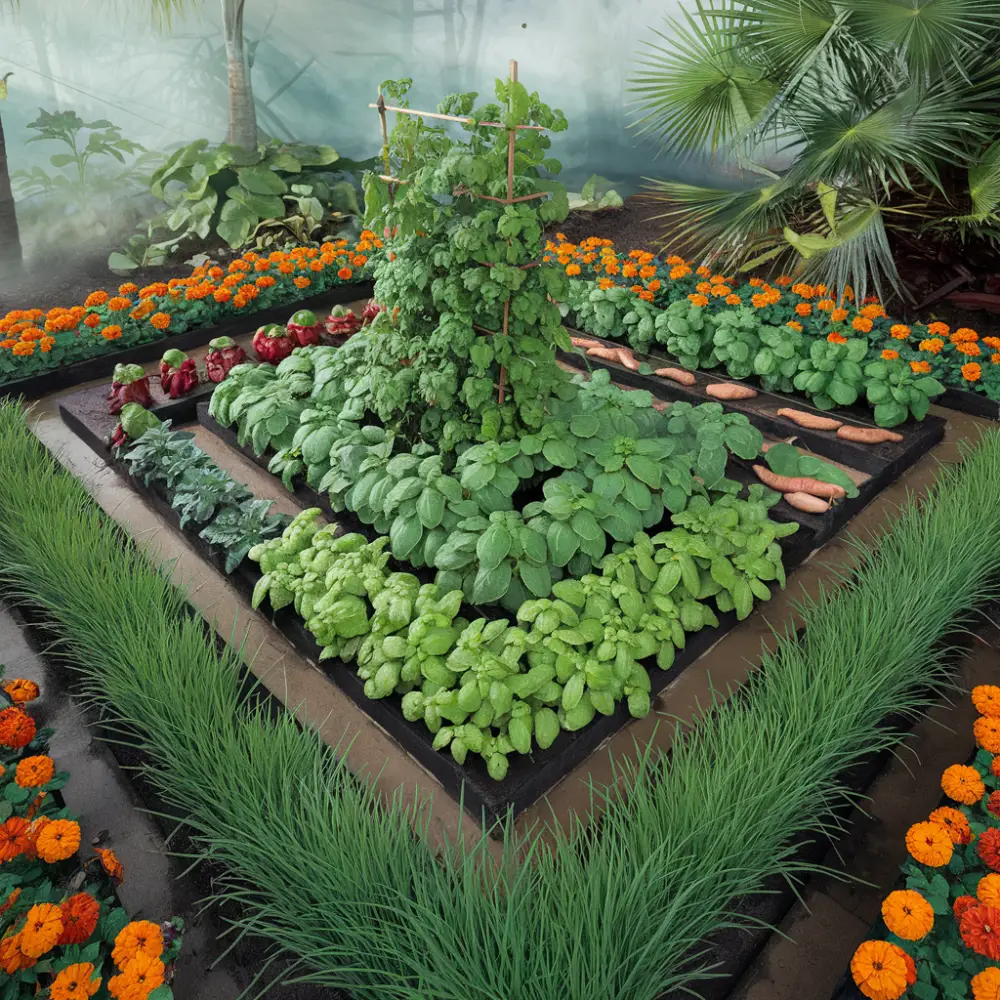If you live somewhere hot, wet, and full of slugs — like Hawaii, Puerto Rico, or any tropical coastal region — you already know:
Most gardening advice doesn’t work here.
The pests are brutal. The rain is relentless. And lettuce? Forget it.

But companion planting can still work. You just have to use plants that actually thrive in your climate — and build in slug defense from the start.
Here’s a full system for making it work.
Step 1: Only Use Plants That Like Your Climate
Start with plants that don’t hate humidity, heat, or heavy rainfall. Most classic charts push crops that love mild, dry-ish weather — which is not your reality.
Good picks for tropical-slug zones:
- Leafy greens: Malabar spinach, Okinawa spinach, katuk
- Fruits/veg: Chili peppers, eggplant, cherry tomatoes, okra
- Roots: Ginger, turmeric, sweet potatoes
- Herbs: Thai basil, lemongrass, garlic chives, Cuban oregano
Avoid:
- Lettuce, spinach (the regular kind), most brassicas — slugs destroy them in hours.

Step 2: Group Plants by Function, Not Just Season
Instead of “cool-season” vs “warm-season,” think:
- Scented defenders (basil, garlic chives, lemongrass)
- Slug-resistant staples (Malabar spinach, ginger)
- Attractors (marigolds, nasturtiums, mustard greens — to trap pests away from your real crops)
Put defenders on the outer edge. Plant the slug-magnets farther out as a “sacrifice” layer.
Step 3: Create Natural Barriers (Slugs Hate Dry + Sharp)
Mulch traps moisture = slug hotel. In the tropics, skip soft mulches. Use gritty or sharp barriers instead:
- Crushed coral
- Crushed eggshells
- Coffee grounds (not too thick, or it cakes)
- Charred wood ash (bonus: deters ants)
Spread around seedlings or the base of prized plants. Reapply after heavy rain.
Step 4: Raise What You Can
Slugs are ground-based. Lifting plants off the soil gives you a major advantage. Try:
- Grow bags on cinder blocks
- Hanging baskets for herbs
- Wall planters for spinach, chives, or strawberries
Even a few inches can make a difference.

Step 5: Use Strong-Scented Herbs as Natural Repellents
These won’t make you 100% slug-proof, but they help:
- Lemongrass: Great in corners and borders, needs space
- Thai basil: Dense and fragrant, works well near peppers
- Cuban oregano: Thick leaves and strong odor = less slug interest
Interplant herbs every 1–2 feet along the border. Think of them as a living fence.
Step 6: Add Vertical Plants to Reduce Moisture Zones
Slugs love low, shady, wet zones. Combat that by using upright plants in the mix:
- Trellised beans
- Climbing cucumbers
- Pole tomatoes
- Sugar cane or corn (if space allows)
This lifts foliage off the soil and dries the lower zone faster after rain.
Step 7: Use Trap Crops (On Purpose)
Some plants are irresistible to slugs. Use them strategically:
- Mustard greens
- Bok choy
- Regular spinach
Plant them away from your real garden, near a beer trap or shaded area. Check daily. These soak up most of the slug activity.

Step 8: Night Patrol or Beer Traps (It’s Old School, But It Works)
Right after sunset or early morning, grab a flashlight and do a quick slug run.
Or bury a shallow dish of beer (cheap stuff works fine) near your slug traps. They’ll fall in and drown.
Repeat after big rains.
Step 9: Focus on Plant Density, Not Perfection
In tropical areas, companion gardening should be messy. Tight spacing actually helps:
- Less exposed soil = fewer slug paths
- Easier to block weeds
- Slugs prefer open, wet ground — not dense roots and stems
Plant in blocks and clusters, not neat rows. Fill every inch.
Step 10: Rotate Often. Clean Up Always.
Never let dead leaves pile up. Slugs love decaying matter.
At the end of each crop cycle, pull plants, clean debris, and reapply your barrier materials.
Tropical Companion Planting Layout Example:
Bed setup idea (4×8 bed in Zone 11)
- Border (slug control): Lemongrass + Thai basil
- Center row (trellised): Malabar spinach and climbing cucumbers
- Sides: Sweet potatoes + garlic chives
- Corners: Marigolds and chili peppers
- Nearby trap zone: Mustard greens + beer trap
Want Help Picking the Right Plants for Your Climate?
If you’re not sure what works in your zone — or you’re tired of trial and error with slug-prone crops — use the Tropical Companion Gardening Calculator I built.
Just enter a few details:
- Your location or USDA zone
- How much rain you get
- What you’re growing in (beds, containers, bags)
- Pest pressure level (low, medium, full-on slug war)
And it’ll give you:
- A slug-smart plant list
- Suggested layout (border, center, trap crops)
- Slug defense tips tailored to your setup
No charts. No fluff. Just a plan that works where you live.
Tropical Plant Companion Calculator
Find the perfect plant combinations for hot, wet growing conditions
Your Growing Environment
Based on your growing conditions:
Recommended Plants
These plants will thrive in your conditions and work well together:
Suggested Garden Layout
Arrange your plants in this pattern for optimal growth and pest resistance:
Slug & Pest Defense Strategies
Note: These recommendations are based on general growing principles for tropical and subtropical regions. Local conditions may vary. For the most accurate advice specific to your garden, consult your local agricultural extension office or experienced gardeners in your area.
Final Thought
You don’t need to give up growing your own food just because you live in a slug-prone jungle. You just need a different system — one that actually fits your climate.
